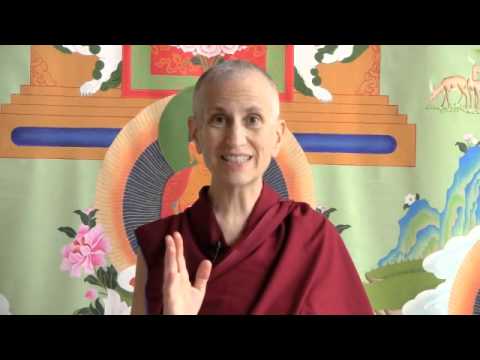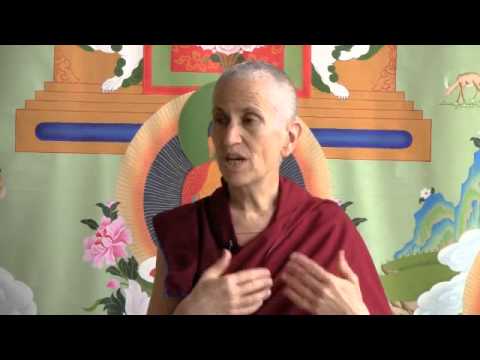Kaleidescope wheel
Sharing reflections on a death

A kaleidoscope is a tube of mirrors containing loose, colored beads and bits of glass. As the viewer looks into one end, light entering the other end reflects off the mirrors, creating the appearance of a colorful design. With each slight rotation of the tube, the tumbling beads reconfigure into new patterns. “Kaleidoscope” literally means “observer of beautiful forms.” Through just such a lens, our friend Mary revealed a Dharma teaching.
I didn’t know her well. We had shared together over the years in various discussion groups during Ven. Chodron’s meditation retreats at Cloud Mountain. I had enjoyed her easy laugh, her inquisitive mind, and felt simpatico based on nothing more than that. You know—how we make friends (and enemies and strangers) on superficial data.
Late last spring she reached out to the Abbey with the news of her terminal condition. Her disease was progressive and fatal. From her symptoms, doctors could predict the pathway of decline; the only question was how long it would take. I became one of her “meditation buddies,” phoning twice a week to share 30 minutes together with Chenrezig, Buddha of Compassion.
The phone contact was focused and contained. We didn’t connect to chat. Our purpose was meditation, and we went straight to it. I learned a few details of her life: how her parents, partner, and children were coping with her prognosis; how she was most afraid of the fear itself, and of the growing discomfort as death approached.
I looked forward to these sessions, stopping whatever I was doing at the appointed time, taking the phone to the meditation hall, adjusting my mind and motivation, then dialing her number. Her ability to communicate verbally declined steadily over the months, but her “hello” was always hearty and distinct.
For a few moments, our worlds would merge as I imagined myself in her room on a quiet street overlooking Puget Sound with all the Holy Beings beaming from the statues and thangkas in the Abbey’s meditation hall. There was clarity and kindness in her silence as we visualized Chenrezig, and then did the practice together, me chanting and reciting out loud the prayers and mantras she could no longer say.
We shared our final practice together on the day that she died.
The seeming suddenness of her death shocked me. I knew it was coming, of course, but despite years of practice, the startled mind questions, “Where in the world did she go?”
Wanting tangible contact, I searched for a photo online where I found a lovely tribute to her. Written by a colleague just a few months before, it revealed myriad glittering details of a wonderful life. It was like I had known Mary through a narrow keyhole and the article opened a window. Simply through the accident of timing—of reading about her life just after her death—that window revealed a world that had never existed as it appeared, and now was completely gone.
A successful professional, Mary was well respected by her colleagues and well loved by her friends, husband, and children. I read how her father’s commitment to progressive causes had inspired her life of service. She openly professed her meditation practice and recommended it to others for maintaining clarity and open-heartedness in working with difficult clients.
Winner of awards, leader of this cause and that organization, a lover of peace and efficiency, and devoted to family—these characteristics and more appeared like fantastically colored cards, stacked with architectural precision to construct the appearance of a beautiful life. Yet now, in the absence of the “person” around whom it had been built, the cards seemed to fall like ashes from a bonfire.
Where there was a life, now there is none. Where we thought there was a person, now there is none. For a brief moment I could see, through the slight shift of the kaleidoscope of cyclic existence, that person had never existed in the way that we all thought, in the way that she had appeared.
And neither do I.
Over these months of opening our hearts together over the phone to the Buddha of Compassion, Chenrezig, there have been many sweet moments of Dharma insight, but none more precious than this.
Mary had a wonderful life. Her grieving loved ones lost a kind and generous friend. The wheel of life turns. The kaleidoscope shifts. Somewhere a new life begins, and the creation of card-houses begins anew.
These facts are not negated by a simultaneous truth: nothing and no one exists in the way that they appear.
Venerable Thubten Chonyi
Ven. Thubten Chonyi is a nun in the Tibetan Buddhist tradition. She has studied with Sravasti Abbey founder and abbess Ven. Thubten Chodron since 1996. She lives and trains at the Abbey, where she received novice ordination in 2008. She took full ordination at Fo Guang Shan in Taiwan in 2011. Ven. Chonyi regularly teaches Buddhism and meditation at the Unitarian Universalist Church of Spokane and, occasionally, in other locations as well.


